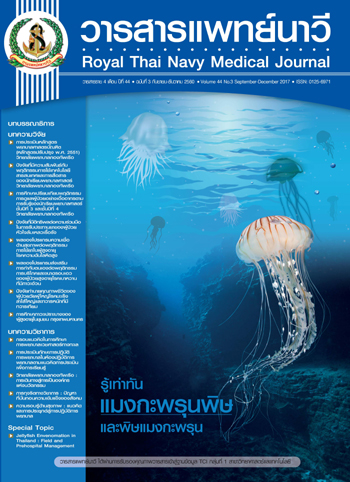การศึกษาภาวะเปราะบางของผู้สูงอายุในชุมชน กรุงเทพมหานคร
Main Article Content
Abstract
This study was a descriptive research. The objectives of this study were to examine
the prevalence of frailty and relationships between frailty status by age, gender, level of
education, falls history, polypharmacy, depression and cognitive impairment in older people
resided in Bangkok communities. The sample consists of 420 people who was over 60
years old and lived in Bangkok communities. The sample was selected using the multi-stage
random sampling method. The instruments used were a personal information questionnaire,
Thai Geriatric Depression Scale, Mini-Mental State Examination: Thai version and Frailty
questionnaire referenced by Fried frail index. The Frailty questionnaire was validated content
validity by the expert. Data were analyzed by using statistic methods, frequency, percentage
and Chi-square test. The results of the study were as follows:
1. The prevalence of frailty in the elderly subjects in Bangkok communities was
32.14 percent.
2. Personal factors include age, gender, marital status, education level, polypharmacy,
underlying diseases, falls history, history of admission in the last year, depression and cognitive
impairment found associated with frailty with a statistically significant at .05 level.
Article Details

This work is licensed under a Creative Commons Attribution-NonCommercial-NoDerivatives 4.0 International License.
References
2. Fried LP, Tangen CM, Walston J, Newman AB, Hirsch C, Gottdiener J, et al. Frailty in older adults: evidence for a phenotype. J Gerontol A Biol Sci Med Sci 2001;56(3):146-56.
3. Andrew MK, Mitnitski AB, Rockwood K. Social vulnerability, frailty and mortality in elderly people. PLoS One 2008;3(5):e22320
4. Borges LL, Menezes RL. Definitions and markers of frailty: A systematic review of the literature. J Gerontol 2001;21:67-77.
5. Collard RM, Boter H, Schoevers RA, Oude Voshaar RC. Prevalence of frailty in community–dwelling older persons: A systematic review. J Am Geriatr Soc 2012;60(8):1487-92.
6. Andela RM, Dijkstra A, Slaets JP, Sanderman R. Prevalence of frailty on clinical on clinical wards: description and implications. Int J Nurs Pract 2010;16(1):14-9.
7. Syddall H, Roberts HC, Evandrou M, Cooper C, Bergman H, Aihie Sayer A. Prevalence and correlate of frailty among community–dwelling older men and women: findings from the Hertfordshire Cohort Study. Age Ageing 2010;39(2):197-203.
8. Chen CY, Wu SC, Chen LJ, Lue BH. The prevalence of subjective frailty and factors associated with frailty in Taiwan. Arch Gerontol Geriatr 2010;50 Suppl 1:S43-7.
9. Runzer-Colmenares FM, Samper-Ternent R, Al Snih S, Ottenbacher KJ, Parodi JF, Wong R. Prevalence and factors associated with frailty among Peruvian older adults. Arch Gerontol Geriatr 2014;58(1):69-73.
10. Moreira VG, Lourenço RA. Prevalence and factors associated with frailty in an older population from the city of Rio de Janeiro Brazil: the FIBRA-RJ Study. Clinics (Sao Paulo) 2013;68(7):979-85.
11. Alvarado BE, Zunzunegui MV, Béland F, Bamvita JM. Life course social and health conditions linked to frailty in Latin American older men and women. J Gerontol A Biol Sci Med Sci 2008;63(12):1399-406.
12. Santos-Eggimann B, Cuénoud P, Spagnoli J, Junod J. Prevalence of frailty in middle-aged and older community–dwelling Europeans living in 10 countries. J Gerontol A Biol Sci Med Sci 2009;64(6):675-81.
13. Song X, Mitnitski A, Rockwood K. Prevalence and 10–year outcomes of frailty in older adults in relation to deficit accumulation. J Am Geriatr Soc 2010;58(4):681-7.
14. อารีย์วรรณ อ่วมตานี. เอกสารคำสอนวิชาการพัฒนาเครื่องมือวิจัยทางการพยาบาล. กรุงเทพมหานคร: คณะพยาบาลศาสตร์ จุฬาลงกรณ์มหาวิทยาลัย; 2552. (อัดสำเนา).
15. บุญใจ ศรีสถิตนรากูร. ระเบียบวิธีการวิจัยทางพยาบาลศาสตร์. พิมพ์ครั้งที่ 4. กรุงเทพมหานคร: ยูแอนด์ไอ อินเตอร์ มีเดีย; 2550.
16. นุชอนงค์ อินทนู. ภาวะหง่อมเกินวัย: การวิเคราะห์สถานการณ์ในชุมชน. [วิทยานิพนธ์พยาบาลศาสตรมหาบัณฑิต สาขาการพยาบาลเวชปฏิบัติชุมชน]. มหาวิทยาลัยวลัยลักษณ์; 2555.
17. จินตนา สุวิทวัส. ภาวะโภชนาการและบริโภคนิสัยของผู้สูงอายุที่เข้าพักรักษาตัวในแผนกการบำบัดพิเศษ. วารสารพยาบาลศาสตร์และสุขภาพ 2554;34(3):22-30.
18. ปณิตา ลิมปะวัฒนะ. ปัญหาในการใช้ยาในผู้สูงอายุ. วารสารศาสตร์อีสาน 2554;10(3):52-65.
19. ลัดดา เถียมวงศ์, เรวดี เพชรศิราสัณห์. ปัจจัยเสี่ยงต่อการหกล้มในผู้สูงอายุไทยที่อาศัยอยู่ในบ้านพักคนชรา. วารสารสภาการพยาบาล 2552;24(1):77-87.
20. มูลนิธิสถาบันวิจัยและพัฒนาผู้สูงอายุไทย. สถานการณ์ผู้สูงอายุไทย 2552. กรุงเทพมหานคร: ทีคิวพี; 2553.
21. Espinoza S, Walston JD. Frailty in older adults: Insights and interventions. Cleve Clin J Med 2005;72(12):1105-12.
22. วิไลพร ขำวงษ์, จตุพร หนูสวัสดิ์, วรารัตน์ ประทานวรปัญญา, จิดาภา ศิริปัญญา. ปัจจัยที่มีความสัมพันธ์กับคุณภาพชีวิตของผู้สูงอายุ. วารสารวิจัยทางวิทยาศาสตร์สุขภาพ 2544;5(2):32-40.

